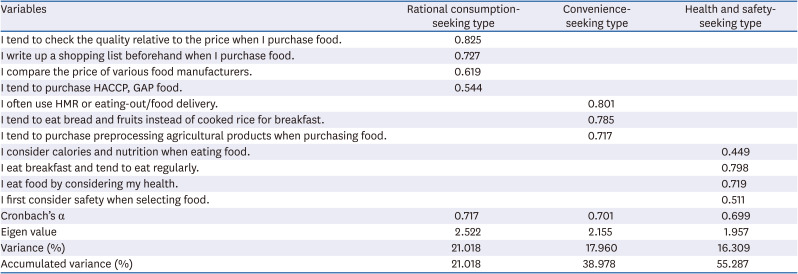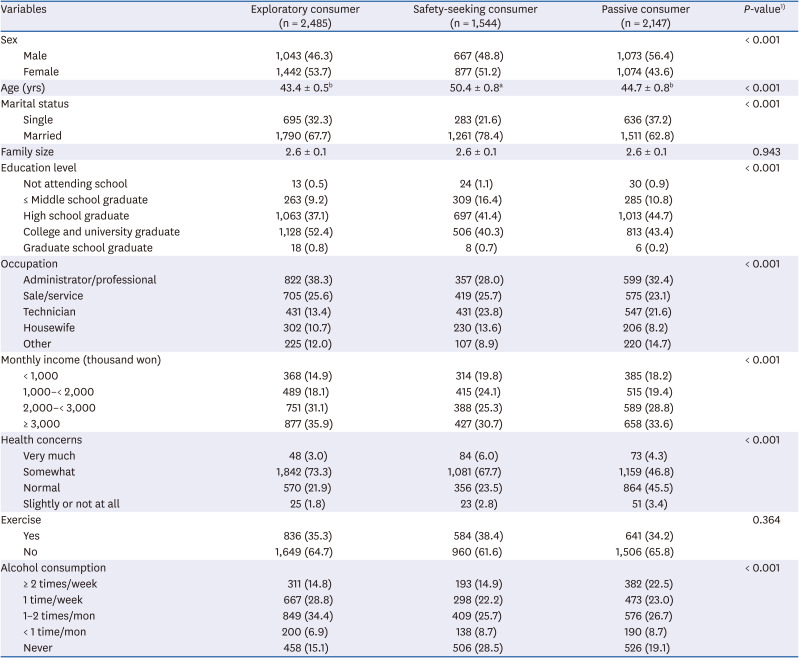1. Salleh MM, Ali SM, Harun EH, Jalil MA, Shaharudin MR. Consumer's perception and purchase intentions towards organic food products: exploring attitude among academician. Can Soc Sci. 2010; 6:119–129.
2. Lee SH, Ryoo JY, Lee MA. Analysis of food choice motivation according to health consciousness of overseas consumers: focus on American and Japanese consumers. J Nutr Health. 2020; 53:431–444.

3. Paul J, Rana J. Consumer behavior and purchase intention for organic food. J Consum Mark. 2012; 29:412–422.

4. Megicks P, Memery J, Williams J. Influences on ethical and socially responsible shopping: evidence from the UK grocery sector. J Mark Manage. 2008; 24:637–659.

5. In : Kumar S, Ali J, editors. Analyzing the factors affecting consumer awareness on organic foods in India. Proceedings of the 21st annual IFAMA world forum and symposium on the road to 2050; 2011 Jun 20-23; Frankfurt, Germany.
6. Grunert KG, Brunsø K, Bredahl L, Bech AC. Food-related lifestyle: a segmentation approach to European food consumers. Frewer LJ, Risvik E, Schifferstein H, editors. Food, People and Society. Berlin, Heidelberg: Springer;2001. p. 211–230.
7. Kim S, Lee K, Lee Y. Selection attributes of home meal replacement by food-related lifestyles of single-person households in South Korea. Food Qual Prefer. 2018; 66:44–51.

8. Yeo GE, Cho MS, Oh J. Food-related lifestyle segmentation and beverage attribute' selection: toward understanding of sugar-reduced beverages choice. Br Food J. 2020; 122:3663–3677.

9. Heo SJ, Bae HJ. Analysis of the consumption pattern of delivery food according to food-related lifestyle. J Nutr Health. 2020; 53:547–561.

10. Yi NY, Choi BR, Chang HJ. Opinion of commercialization of ready-to-eat Korean foods by food-related lifestyle segments in Koreans and non-Koreans. J Korean Soc Food Sci Nutr. 2016; 45:602–612.

11. Rana J, Paul J. Consumer behavior and purchase intention for organic food: a review and research agenda. J Retailing Consum Serv. 2017; 38:157–165.

12. Chen MF. Consumer attitudes and purchase intentions in relation to organic foods in Taiwan: moderating effects of food-related personality traits. Food Qual Prefer. 2007; 18:1008–1021.

13. Vidgen HA, Gallegos D. Defining food literacy and its components. Appetite. 2014; 76:50–59. PMID:
24462490.

14. Lee K, Ban H, Park K, Hwang Y. Development and measurement of the index of Agrifood Consumer Competency Index. J Rural Dev. 2014; 37:59–77.
15. Vaitkeviciute R, Ball LE, Harris N. The relationship between food literacy and dietary intake in adolescents: a systematic review. Public Health Nutr. 2015; 18:649–658. PMID:
24844778.

16. Palumbo R. Sustainability of well-being through literacy. The effects of food literacy on sustainability of well-being. Agric Agric Sci Proced. 2016; 8:99–106.

17. Gil JM, Gracia A, Sanchez M. Market segmentation and willingness to pay for organic products in Spain. Int Food Agribus Manag Rev. 2000; 3:207–226.

18. Thomas T, Gunden C. Investigating consumer attitudes toward food produced via three production systems: conventional, sustainable and organic. J Food Agric Environ. 2012; 10:132–135.
19. Van Loo EJ, Diem MN, Pieniak Z, Verbeke W. Consumer attitudes, knowledge, and consumption of organic yogurt. J Dairy Sci. 2013; 96:2118–2129. PMID:
23415537.

20. Deliana Y. Market segmentation for organic products in Bandung West Java, Indonesia. Res J Recent Sci. 2012; 2277:2502.
21. Seyfang G. Ecological citizenship and sustainable consumption: examining local organic food networks. J Rural Stud. 2006; 22:383–395.

22. Canavari M, Olson KD. Organic Food: Consumers' Choices and Farmers Opportunities. New York (NY): Springer-Verlag New York;2007.
23. Rahman SM, Mele MA, Lee YT, Islam MZ. Consumer preference, quality, and safety of organic and conventional fresh fruits, vegetables, and cereals. Foods. 2021; 10:105.

24. Bryła P. Organic food consumption in Poland: motives and barriers. Appetite. 2016; 105:737–746. PMID:
27417333.

25. Li R, Lee HY, Lin YT, Liu CW, Tsai PF. Consumers' willingness to pay for organic foods in China: bibliometric review for an emerging literature. Int J Environ Res Public Health. 2019; 16:1713.

28. Apaolaza V, Hartmann P, D'Souza C, López CM. Eat organic–feel good? The relationship between organic food consumption, health concern and subjective wellbeing. Food Qual Prefer. 2018; 63:51–62.

29. Michaelidou N, Hassan LM. The role of health consciousness, food safety concern and ethical identity on attitudes and intentions towards organic food. Int J Consum Stud. 2008; 32:163–170.

30. Makatouni A. What motivates consumers to buy organic food in the UK? Results from a qualitative study. Br Food J. 2002; 104:345–352.
31. Pino G, Peluso AM, Guido G. Determinants of regular and occasional consumers' intentions to buy organic food. J Consum Aff. 2012; 46:157–169.

32. Smith S, Paladino A. Eating clean and green? Investigating consumer motivations towards the purchase of organic food. Australas Mark J. 2010; 18:93–104.

33. Soroka A, Wojciechowska-Solis J. Consumer motivation to buy organic food depends on lifestyle. Foods. 2019; 8:581.

34. Krause C, Sommerhalder K, Beer-Borst S, Abel T. Just a subtle difference? Findings from a systematic review on definitions of nutrition literacy and food literacy. Health Promot Int. 2018; 33:378–389. PMID:
27803197.

35. Rosenbaum DL, Clark MH, Convertino AD, Call CC, Forman EM, Butryn ML. Examination of nutrition literacy and quality of self-monitoring in behavioral weight loss. Ann Behav Med. 2018; 52:809–816. PMID:
30124757.

36. Wickham CA, Carbone ET. What's technology cooking up? A systematic review of the use of technology in adolescent food literacy programs. Appetite. 2018; 125:333–344. PMID:
29471069.

37. Begley A, Paynter E, Butcher L, Bobongie V, Dhaliwal SS. Identifying who improves or maintains their food literacy behaviours after completing an adult program. Int J Environ Res Public Health. 2020; 17:4462.










 PDF
PDF Citation
Citation Print
Print



 XML Download
XML Download